MnM Company Report: Why Managers Must Master Corporate Communication
VerifiedAdded on 2023/04/04
|13
|2172
|210
Report
AI Summary
This report, prepared for the CEO of MnM Company, investigates the critical need for managers to master corporate communication. It delves into four key sub-functions: identity, reputation and image; corporate responsibility; media relations; and crisis management. The report highlights the impact of reputation on stakeholders, the importance of customer service, and the growing demand for corporate social responsibility. It also emphasizes developing social commitments, regaining customer confidence through effective media relations, and involving stakeholders in social media strategies. Furthermore, the report addresses crisis management strategies, including effective planning and identifying target audiences. The report concludes that mastering corporate communication is fundamental to an organization's image and overall success, particularly in managing crises and maintaining a positive public perception.

Title of Report
Name:
Course
Professor’s name
University name
City, State
Date of submission
1
Name:
Course
Professor’s name
University name
City, State
Date of submission
1
Paraphrase This Document
Need a fresh take? Get an instant paraphrase of this document with our AI Paraphraser
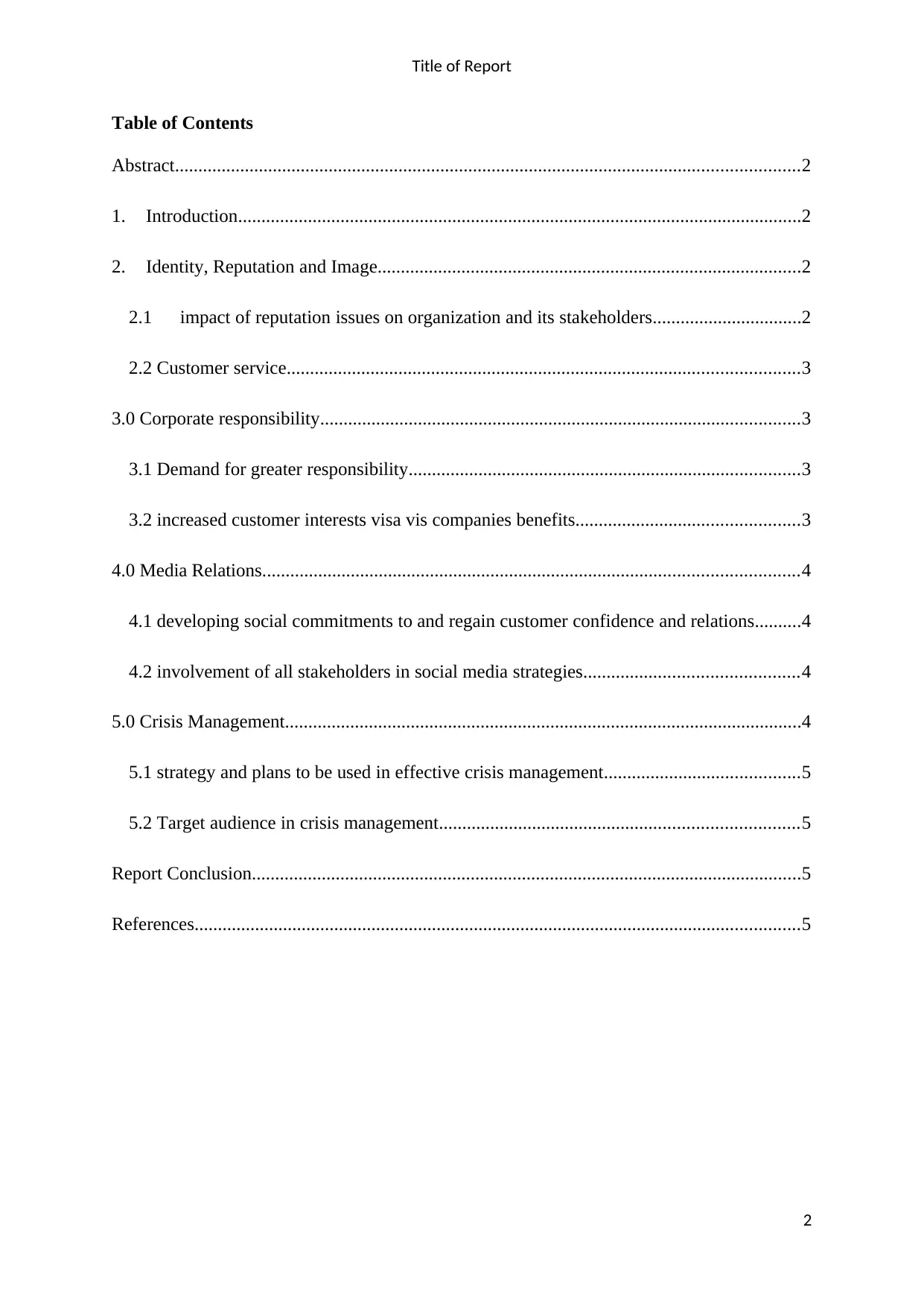
Title of Report
Table of Contents
Abstract......................................................................................................................................2
1. Introduction.........................................................................................................................2
2. Identity, Reputation and Image...........................................................................................2
2.1 impact of reputation issues on organization and its stakeholders................................2
2.2 Customer service..............................................................................................................3
3.0 Corporate responsibility.......................................................................................................3
3.1 Demand for greater responsibility....................................................................................3
3.2 increased customer interests visa vis companies benefits................................................3
4.0 Media Relations...................................................................................................................4
4.1 developing social commitments to and regain customer confidence and relations..........4
4.2 involvement of all stakeholders in social media strategies..............................................4
5.0 Crisis Management...............................................................................................................4
5.1 strategy and plans to be used in effective crisis management..........................................5
5.2 Target audience in crisis management.............................................................................5
Report Conclusion......................................................................................................................5
References..................................................................................................................................5
2
Table of Contents
Abstract......................................................................................................................................2
1. Introduction.........................................................................................................................2
2. Identity, Reputation and Image...........................................................................................2
2.1 impact of reputation issues on organization and its stakeholders................................2
2.2 Customer service..............................................................................................................3
3.0 Corporate responsibility.......................................................................................................3
3.1 Demand for greater responsibility....................................................................................3
3.2 increased customer interests visa vis companies benefits................................................3
4.0 Media Relations...................................................................................................................4
4.1 developing social commitments to and regain customer confidence and relations..........4
4.2 involvement of all stakeholders in social media strategies..............................................4
5.0 Crisis Management...............................................................................................................4
5.1 strategy and plans to be used in effective crisis management..........................................5
5.2 Target audience in crisis management.............................................................................5
Report Conclusion......................................................................................................................5
References..................................................................................................................................5
2
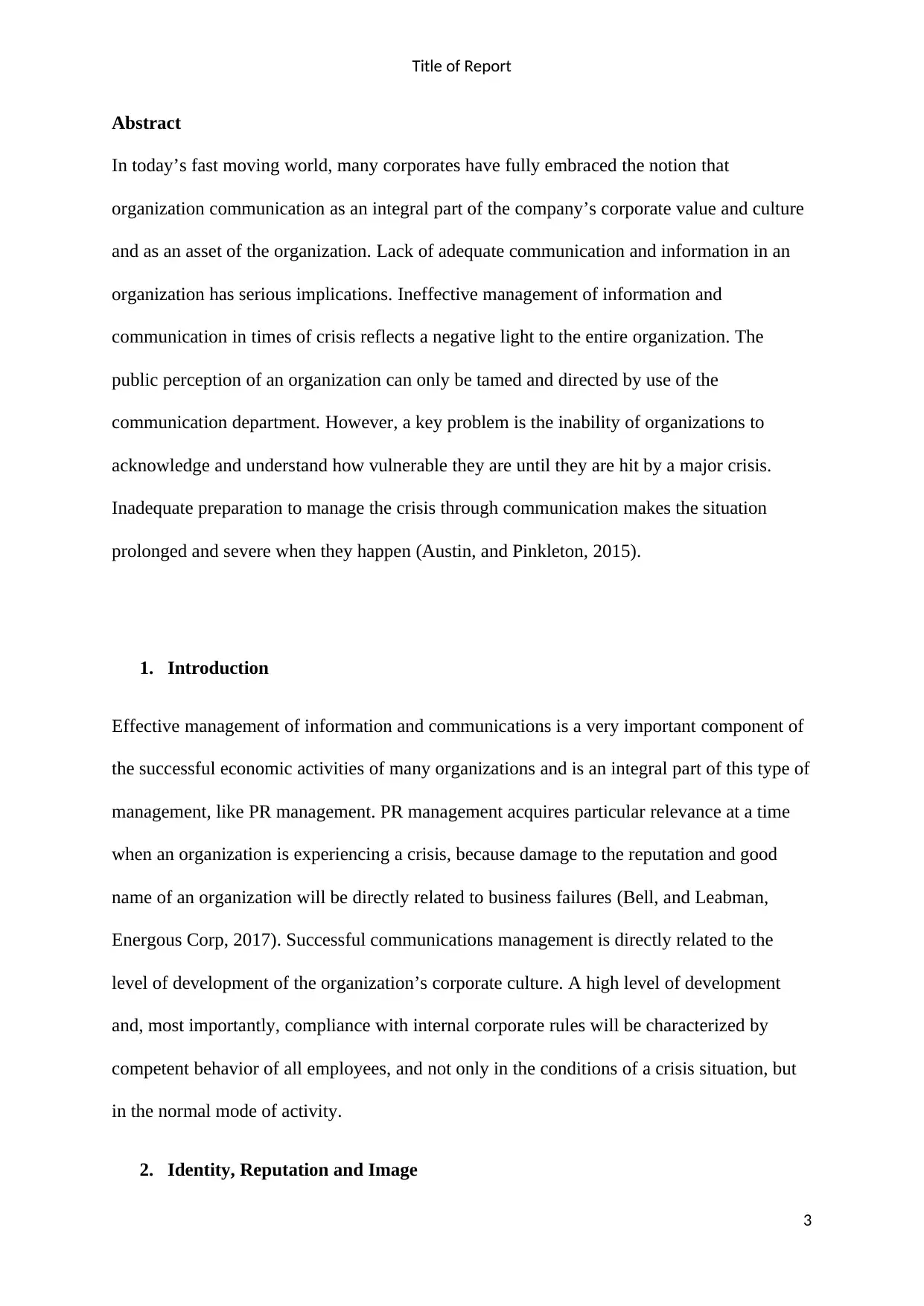
Title of Report
Abstract
In today’s fast moving world, many corporates have fully embraced the notion that
organization communication as an integral part of the company’s corporate value and culture
and as an asset of the organization. Lack of adequate communication and information in an
organization has serious implications. Ineffective management of information and
communication in times of crisis reflects a negative light to the entire organization. The
public perception of an organization can only be tamed and directed by use of the
communication department. However, a key problem is the inability of organizations to
acknowledge and understand how vulnerable they are until they are hit by a major crisis.
Inadequate preparation to manage the crisis through communication makes the situation
prolonged and severe when they happen (Austin, and Pinkleton, 2015).
1. Introduction
Effective management of information and communications is a very important component of
the successful economic activities of many organizations and is an integral part of this type of
management, like PR management. PR management acquires particular relevance at a time
when an organization is experiencing a crisis, because damage to the reputation and good
name of an organization will be directly related to business failures (Bell, and Leabman,
Energous Corp, 2017). Successful communications management is directly related to the
level of development of the organization’s corporate culture. A high level of development
and, most importantly, compliance with internal corporate rules will be characterized by
competent behavior of all employees, and not only in the conditions of a crisis situation, but
in the normal mode of activity.
2. Identity, Reputation and Image
3
Abstract
In today’s fast moving world, many corporates have fully embraced the notion that
organization communication as an integral part of the company’s corporate value and culture
and as an asset of the organization. Lack of adequate communication and information in an
organization has serious implications. Ineffective management of information and
communication in times of crisis reflects a negative light to the entire organization. The
public perception of an organization can only be tamed and directed by use of the
communication department. However, a key problem is the inability of organizations to
acknowledge and understand how vulnerable they are until they are hit by a major crisis.
Inadequate preparation to manage the crisis through communication makes the situation
prolonged and severe when they happen (Austin, and Pinkleton, 2015).
1. Introduction
Effective management of information and communications is a very important component of
the successful economic activities of many organizations and is an integral part of this type of
management, like PR management. PR management acquires particular relevance at a time
when an organization is experiencing a crisis, because damage to the reputation and good
name of an organization will be directly related to business failures (Bell, and Leabman,
Energous Corp, 2017). Successful communications management is directly related to the
level of development of the organization’s corporate culture. A high level of development
and, most importantly, compliance with internal corporate rules will be characterized by
competent behavior of all employees, and not only in the conditions of a crisis situation, but
in the normal mode of activity.
2. Identity, Reputation and Image
3
⊘ This is a preview!⊘
Do you want full access?
Subscribe today to unlock all pages.

Trusted by 1+ million students worldwide
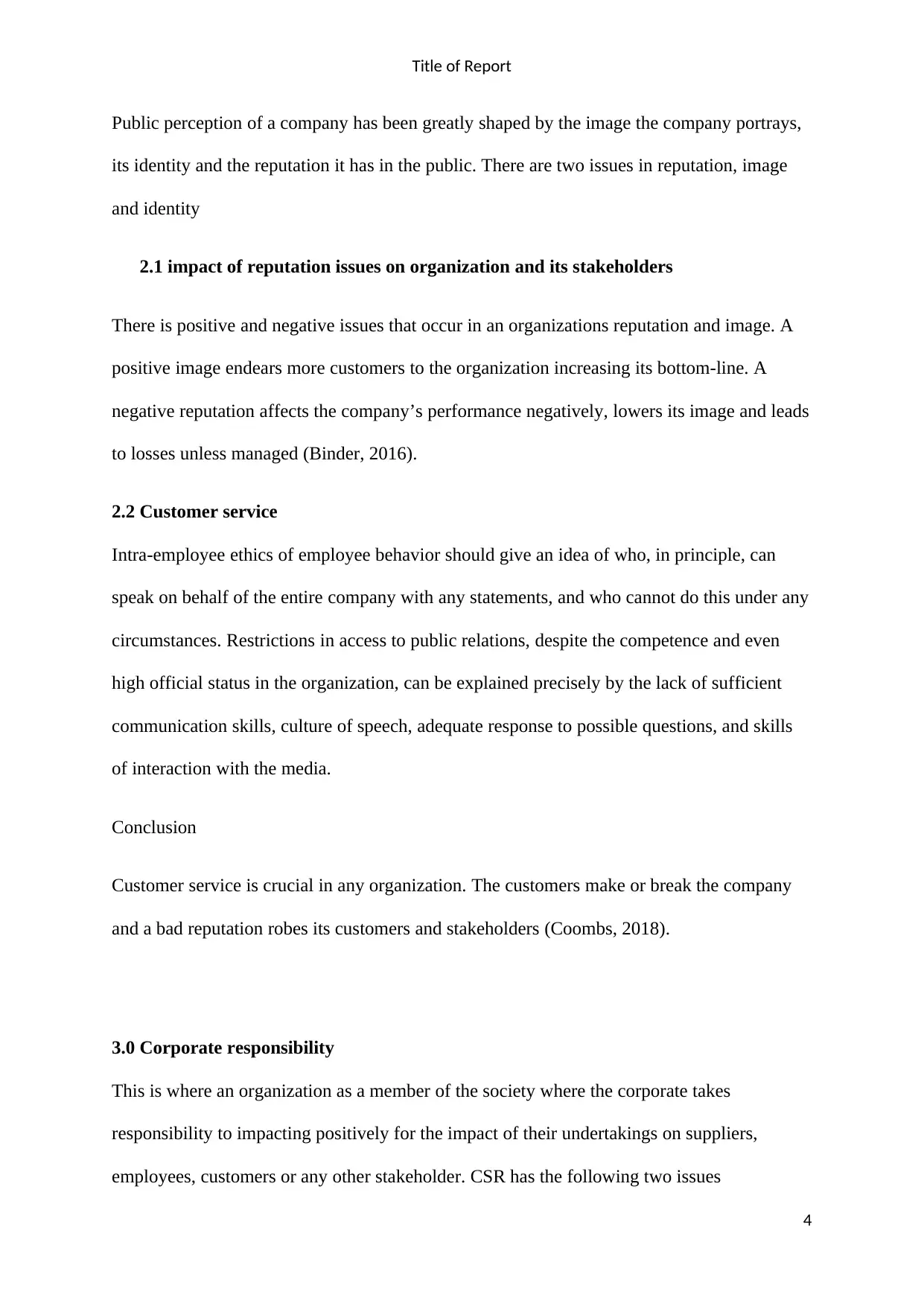
Title of Report
Public perception of a company has been greatly shaped by the image the company portrays,
its identity and the reputation it has in the public. There are two issues in reputation, image
and identity
2.1 impact of reputation issues on organization and its stakeholders
There is positive and negative issues that occur in an organizations reputation and image. A
positive image endears more customers to the organization increasing its bottom-line. A
negative reputation affects the company’s performance negatively, lowers its image and leads
to losses unless managed (Binder, 2016).
2.2 Customer service
Intra-employee ethics of employee behavior should give an idea of who, in principle, can
speak on behalf of the entire company with any statements, and who cannot do this under any
circumstances. Restrictions in access to public relations, despite the competence and even
high official status in the organization, can be explained precisely by the lack of sufficient
communication skills, culture of speech, adequate response to possible questions, and skills
of interaction with the media.
Conclusion
Customer service is crucial in any organization. The customers make or break the company
and a bad reputation robes its customers and stakeholders (Coombs, 2018).
3.0 Corporate responsibility
This is where an organization as a member of the society where the corporate takes
responsibility to impacting positively for the impact of their undertakings on suppliers,
employees, customers or any other stakeholder. CSR has the following two issues
4
Public perception of a company has been greatly shaped by the image the company portrays,
its identity and the reputation it has in the public. There are two issues in reputation, image
and identity
2.1 impact of reputation issues on organization and its stakeholders
There is positive and negative issues that occur in an organizations reputation and image. A
positive image endears more customers to the organization increasing its bottom-line. A
negative reputation affects the company’s performance negatively, lowers its image and leads
to losses unless managed (Binder, 2016).
2.2 Customer service
Intra-employee ethics of employee behavior should give an idea of who, in principle, can
speak on behalf of the entire company with any statements, and who cannot do this under any
circumstances. Restrictions in access to public relations, despite the competence and even
high official status in the organization, can be explained precisely by the lack of sufficient
communication skills, culture of speech, adequate response to possible questions, and skills
of interaction with the media.
Conclusion
Customer service is crucial in any organization. The customers make or break the company
and a bad reputation robes its customers and stakeholders (Coombs, 2018).
3.0 Corporate responsibility
This is where an organization as a member of the society where the corporate takes
responsibility to impacting positively for the impact of their undertakings on suppliers,
employees, customers or any other stakeholder. CSR has the following two issues
4
Paraphrase This Document
Need a fresh take? Get an instant paraphrase of this document with our AI Paraphraser
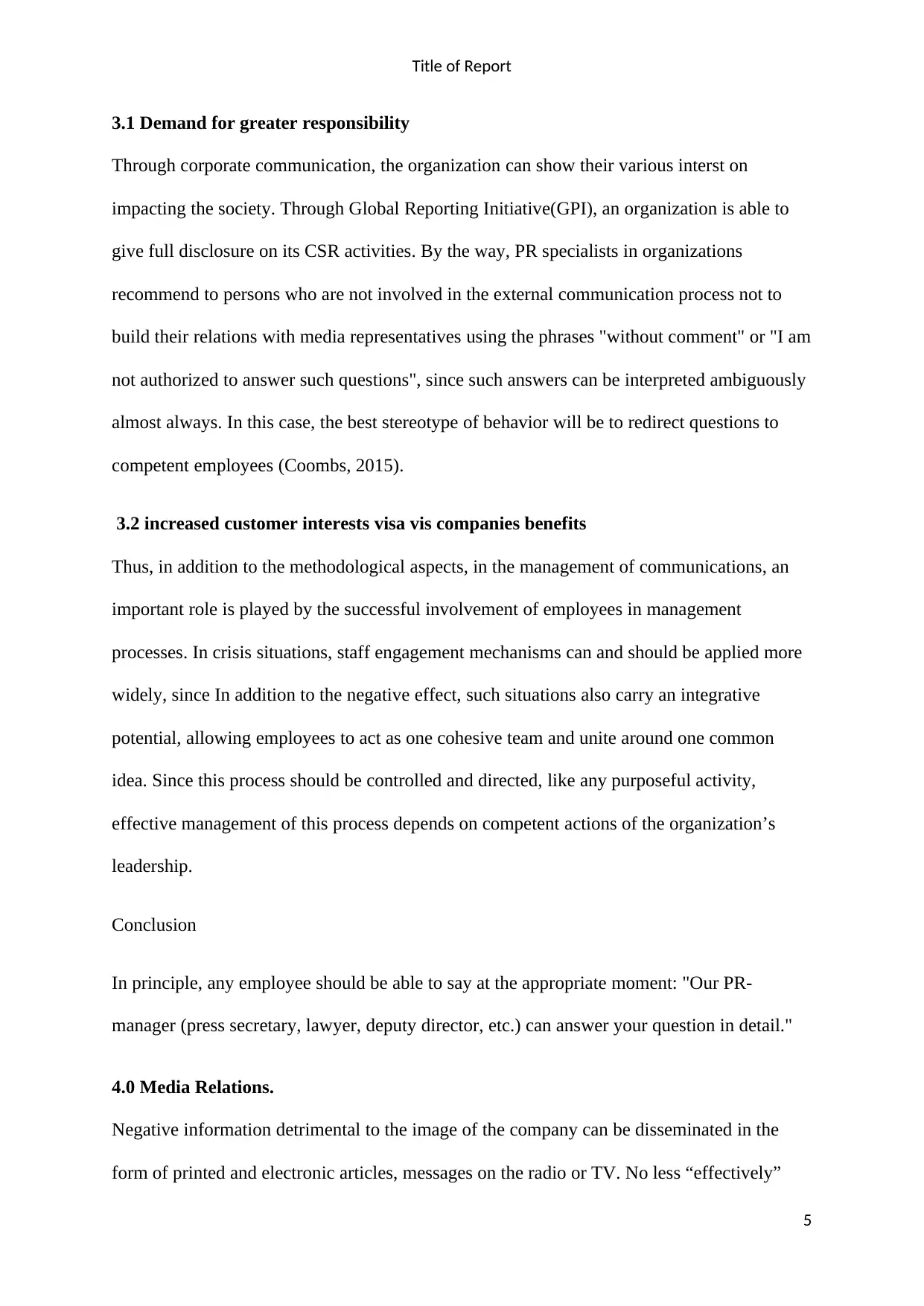
Title of Report
3.1 Demand for greater responsibility
Through corporate communication, the organization can show their various interst on
impacting the society. Through Global Reporting Initiative(GPI), an organization is able to
give full disclosure on its CSR activities. By the way, PR specialists in organizations
recommend to persons who are not involved in the external communication process not to
build their relations with media representatives using the phrases "without comment" or "I am
not authorized to answer such questions", since such answers can be interpreted ambiguously
almost always. In this case, the best stereotype of behavior will be to redirect questions to
competent employees (Coombs, 2015).
3.2 increased customer interests visa vis companies benefits
Thus, in addition to the methodological aspects, in the management of communications, an
important role is played by the successful involvement of employees in management
processes. In crisis situations, staff engagement mechanisms can and should be applied more
widely, since In addition to the negative effect, such situations also carry an integrative
potential, allowing employees to act as one cohesive team and unite around one common
idea. Since this process should be controlled and directed, like any purposeful activity,
effective management of this process depends on competent actions of the organization’s
leadership.
Conclusion
In principle, any employee should be able to say at the appropriate moment: "Our PR-
manager (press secretary, lawyer, deputy director, etc.) can answer your question in detail."
4.0 Media Relations.
Negative information detrimental to the image of the company can be disseminated in the
form of printed and electronic articles, messages on the radio or TV. No less “effectively”
5
3.1 Demand for greater responsibility
Through corporate communication, the organization can show their various interst on
impacting the society. Through Global Reporting Initiative(GPI), an organization is able to
give full disclosure on its CSR activities. By the way, PR specialists in organizations
recommend to persons who are not involved in the external communication process not to
build their relations with media representatives using the phrases "without comment" or "I am
not authorized to answer such questions", since such answers can be interpreted ambiguously
almost always. In this case, the best stereotype of behavior will be to redirect questions to
competent employees (Coombs, 2015).
3.2 increased customer interests visa vis companies benefits
Thus, in addition to the methodological aspects, in the management of communications, an
important role is played by the successful involvement of employees in management
processes. In crisis situations, staff engagement mechanisms can and should be applied more
widely, since In addition to the negative effect, such situations also carry an integrative
potential, allowing employees to act as one cohesive team and unite around one common
idea. Since this process should be controlled and directed, like any purposeful activity,
effective management of this process depends on competent actions of the organization’s
leadership.
Conclusion
In principle, any employee should be able to say at the appropriate moment: "Our PR-
manager (press secretary, lawyer, deputy director, etc.) can answer your question in detail."
4.0 Media Relations.
Negative information detrimental to the image of the company can be disseminated in the
form of printed and electronic articles, messages on the radio or TV. No less “effectively”
5
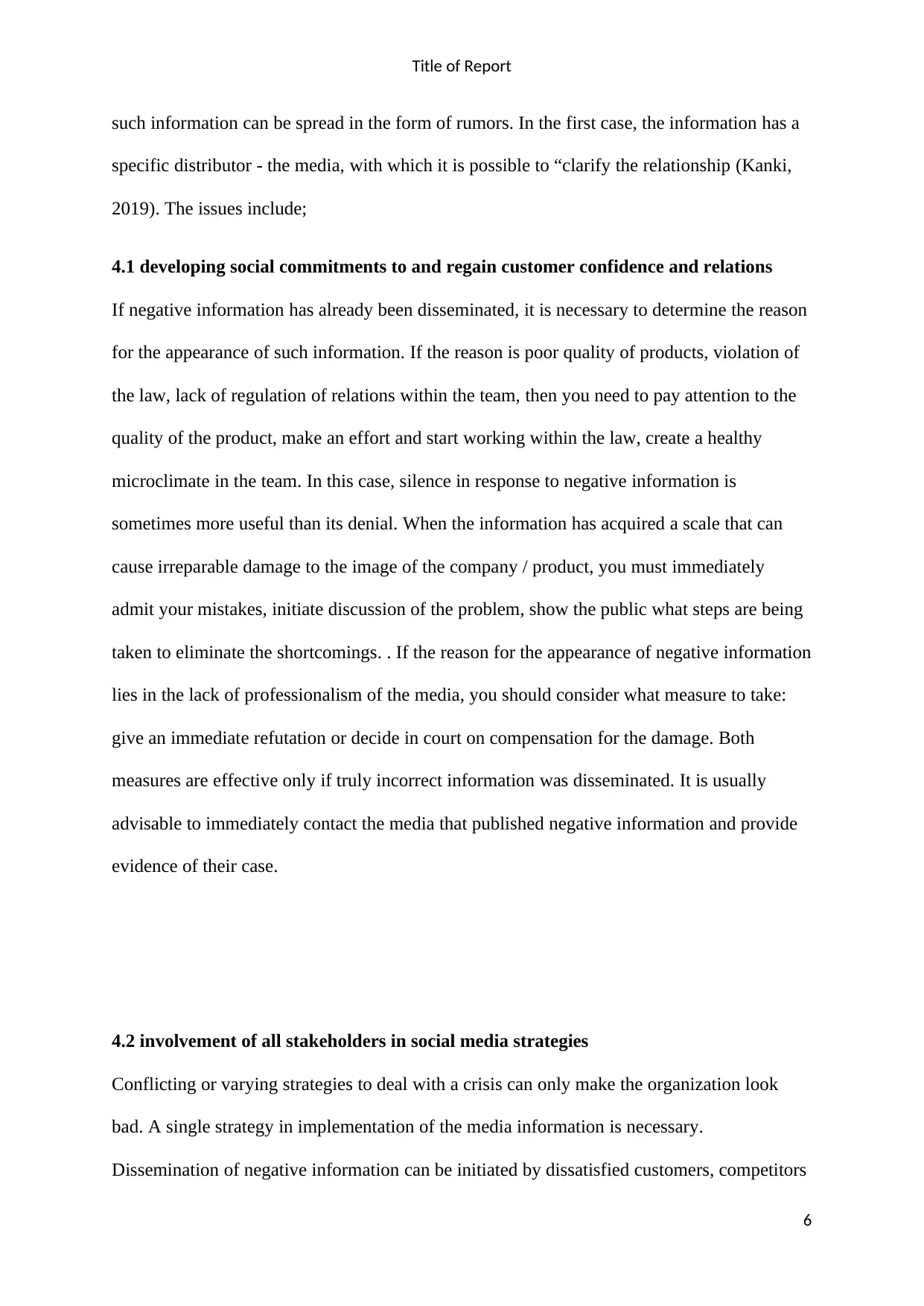
Title of Report
such information can be spread in the form of rumors. In the first case, the information has a
specific distributor - the media, with which it is possible to “clarify the relationship (Kanki,
2019). The issues include;
4.1 developing social commitments to and regain customer confidence and relations
If negative information has already been disseminated, it is necessary to determine the reason
for the appearance of such information. If the reason is poor quality of products, violation of
the law, lack of regulation of relations within the team, then you need to pay attention to the
quality of the product, make an effort and start working within the law, create a healthy
microclimate in the team. In this case, silence in response to negative information is
sometimes more useful than its denial. When the information has acquired a scale that can
cause irreparable damage to the image of the company / product, you must immediately
admit your mistakes, initiate discussion of the problem, show the public what steps are being
taken to eliminate the shortcomings. . If the reason for the appearance of negative information
lies in the lack of professionalism of the media, you should consider what measure to take:
give an immediate refutation or decide in court on compensation for the damage. Both
measures are effective only if truly incorrect information was disseminated. It is usually
advisable to immediately contact the media that published negative information and provide
evidence of their case.
4.2 involvement of all stakeholders in social media strategies
Conflicting or varying strategies to deal with a crisis can only make the organization look
bad. A single strategy in implementation of the media information is necessary.
Dissemination of negative information can be initiated by dissatisfied customers, competitors
6
such information can be spread in the form of rumors. In the first case, the information has a
specific distributor - the media, with which it is possible to “clarify the relationship (Kanki,
2019). The issues include;
4.1 developing social commitments to and regain customer confidence and relations
If negative information has already been disseminated, it is necessary to determine the reason
for the appearance of such information. If the reason is poor quality of products, violation of
the law, lack of regulation of relations within the team, then you need to pay attention to the
quality of the product, make an effort and start working within the law, create a healthy
microclimate in the team. In this case, silence in response to negative information is
sometimes more useful than its denial. When the information has acquired a scale that can
cause irreparable damage to the image of the company / product, you must immediately
admit your mistakes, initiate discussion of the problem, show the public what steps are being
taken to eliminate the shortcomings. . If the reason for the appearance of negative information
lies in the lack of professionalism of the media, you should consider what measure to take:
give an immediate refutation or decide in court on compensation for the damage. Both
measures are effective only if truly incorrect information was disseminated. It is usually
advisable to immediately contact the media that published negative information and provide
evidence of their case.
4.2 involvement of all stakeholders in social media strategies
Conflicting or varying strategies to deal with a crisis can only make the organization look
bad. A single strategy in implementation of the media information is necessary.
Dissemination of negative information can be initiated by dissatisfied customers, competitors
6
⊘ This is a preview!⊘
Do you want full access?
Subscribe today to unlock all pages.

Trusted by 1+ million students worldwide
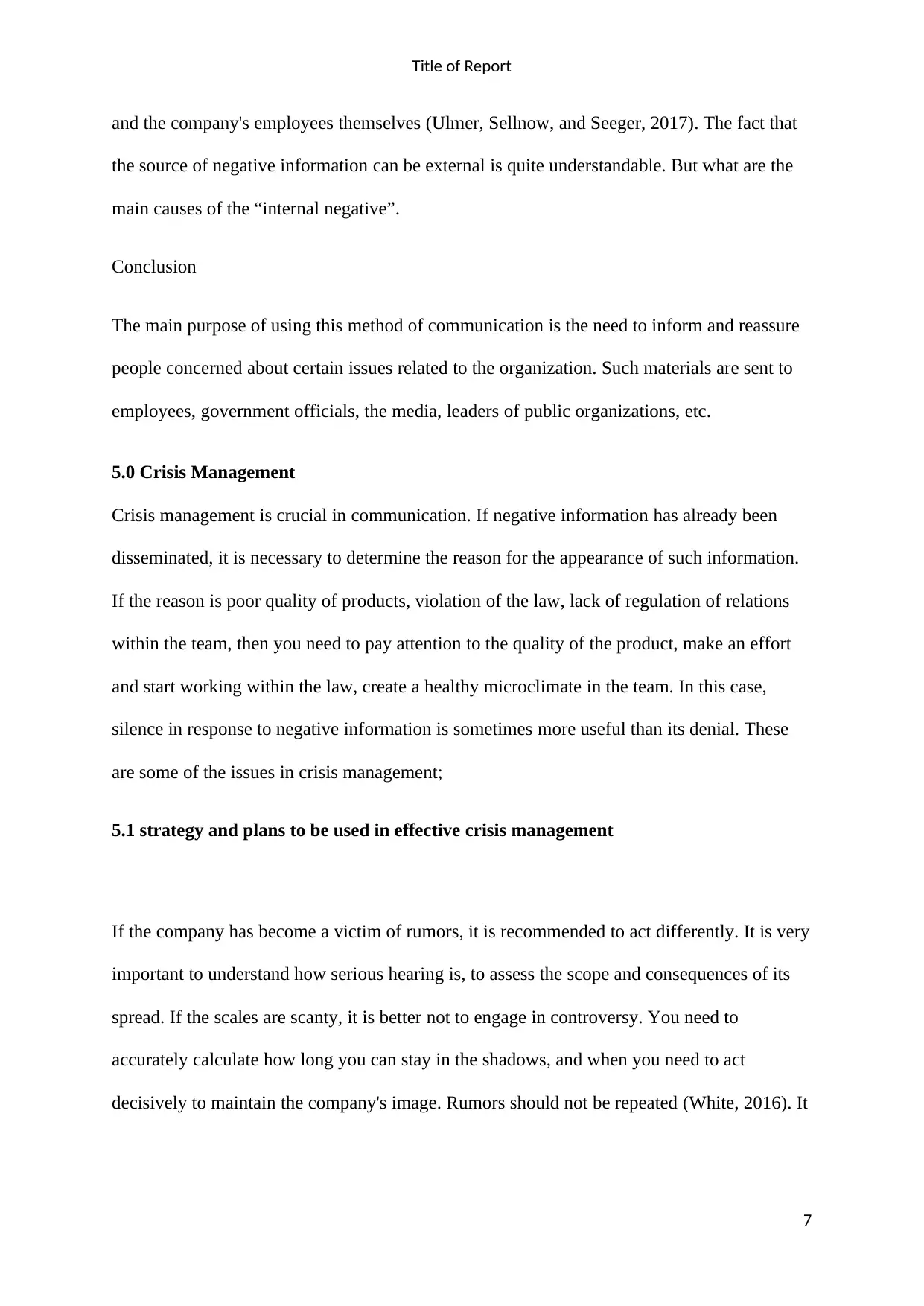
Title of Report
and the company's employees themselves (Ulmer, Sellnow, and Seeger, 2017). The fact that
the source of negative information can be external is quite understandable. But what are the
main causes of the “internal negative”.
Conclusion
The main purpose of using this method of communication is the need to inform and reassure
people concerned about certain issues related to the organization. Such materials are sent to
employees, government officials, the media, leaders of public organizations, etc.
5.0 Crisis Management
Crisis management is crucial in communication. If negative information has already been
disseminated, it is necessary to determine the reason for the appearance of such information.
If the reason is poor quality of products, violation of the law, lack of regulation of relations
within the team, then you need to pay attention to the quality of the product, make an effort
and start working within the law, create a healthy microclimate in the team. In this case,
silence in response to negative information is sometimes more useful than its denial. These
are some of the issues in crisis management;
5.1 strategy and plans to be used in effective crisis management
If the company has become a victim of rumors, it is recommended to act differently. It is very
important to understand how serious hearing is, to assess the scope and consequences of its
spread. If the scales are scanty, it is better not to engage in controversy. You need to
accurately calculate how long you can stay in the shadows, and when you need to act
decisively to maintain the company's image. Rumors should not be repeated (White, 2016). It
7
and the company's employees themselves (Ulmer, Sellnow, and Seeger, 2017). The fact that
the source of negative information can be external is quite understandable. But what are the
main causes of the “internal negative”.
Conclusion
The main purpose of using this method of communication is the need to inform and reassure
people concerned about certain issues related to the organization. Such materials are sent to
employees, government officials, the media, leaders of public organizations, etc.
5.0 Crisis Management
Crisis management is crucial in communication. If negative information has already been
disseminated, it is necessary to determine the reason for the appearance of such information.
If the reason is poor quality of products, violation of the law, lack of regulation of relations
within the team, then you need to pay attention to the quality of the product, make an effort
and start working within the law, create a healthy microclimate in the team. In this case,
silence in response to negative information is sometimes more useful than its denial. These
are some of the issues in crisis management;
5.1 strategy and plans to be used in effective crisis management
If the company has become a victim of rumors, it is recommended to act differently. It is very
important to understand how serious hearing is, to assess the scope and consequences of its
spread. If the scales are scanty, it is better not to engage in controversy. You need to
accurately calculate how long you can stay in the shadows, and when you need to act
decisively to maintain the company's image. Rumors should not be repeated (White, 2016). It
7
Paraphrase This Document
Need a fresh take? Get an instant paraphrase of this document with our AI Paraphraser
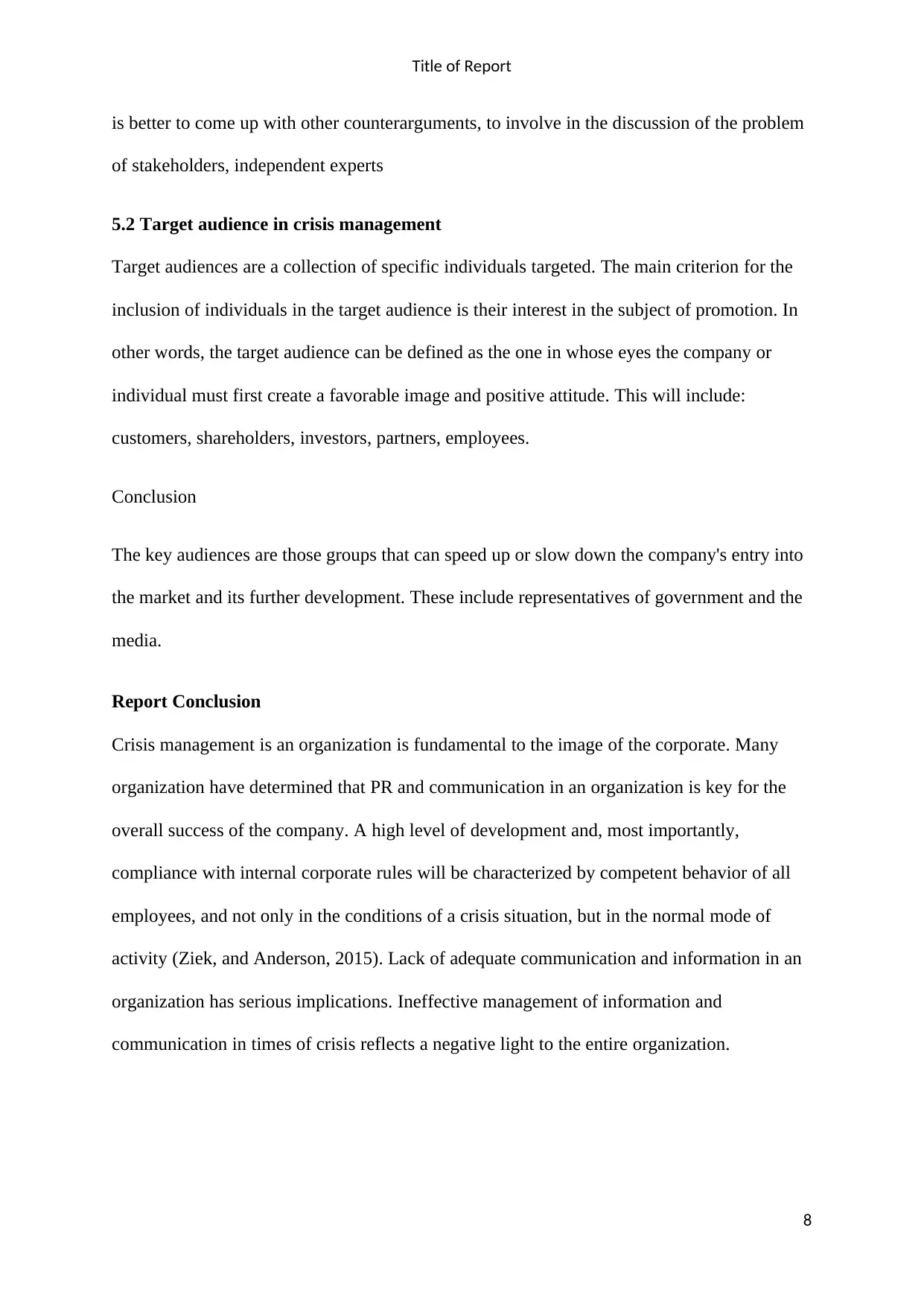
Title of Report
is better to come up with other counterarguments, to involve in the discussion of the problem
of stakeholders, independent experts
5.2 Target audience in crisis management
Target audiences are a collection of specific individuals targeted. The main criterion for the
inclusion of individuals in the target audience is their interest in the subject of promotion. In
other words, the target audience can be defined as the one in whose eyes the company or
individual must first create a favorable image and positive attitude. This will include:
customers, shareholders, investors, partners, employees.
Conclusion
The key audiences are those groups that can speed up or slow down the company's entry into
the market and its further development. These include representatives of government and the
media.
Report Conclusion
Crisis management is an organization is fundamental to the image of the corporate. Many
organization have determined that PR and communication in an organization is key for the
overall success of the company. A high level of development and, most importantly,
compliance with internal corporate rules will be characterized by competent behavior of all
employees, and not only in the conditions of a crisis situation, but in the normal mode of
activity (Ziek, and Anderson, 2015). Lack of adequate communication and information in an
organization has serious implications. Ineffective management of information and
communication in times of crisis reflects a negative light to the entire organization.
8
is better to come up with other counterarguments, to involve in the discussion of the problem
of stakeholders, independent experts
5.2 Target audience in crisis management
Target audiences are a collection of specific individuals targeted. The main criterion for the
inclusion of individuals in the target audience is their interest in the subject of promotion. In
other words, the target audience can be defined as the one in whose eyes the company or
individual must first create a favorable image and positive attitude. This will include:
customers, shareholders, investors, partners, employees.
Conclusion
The key audiences are those groups that can speed up or slow down the company's entry into
the market and its further development. These include representatives of government and the
media.
Report Conclusion
Crisis management is an organization is fundamental to the image of the corporate. Many
organization have determined that PR and communication in an organization is key for the
overall success of the company. A high level of development and, most importantly,
compliance with internal corporate rules will be characterized by competent behavior of all
employees, and not only in the conditions of a crisis situation, but in the normal mode of
activity (Ziek, and Anderson, 2015). Lack of adequate communication and information in an
organization has serious implications. Ineffective management of information and
communication in times of crisis reflects a negative light to the entire organization.
8
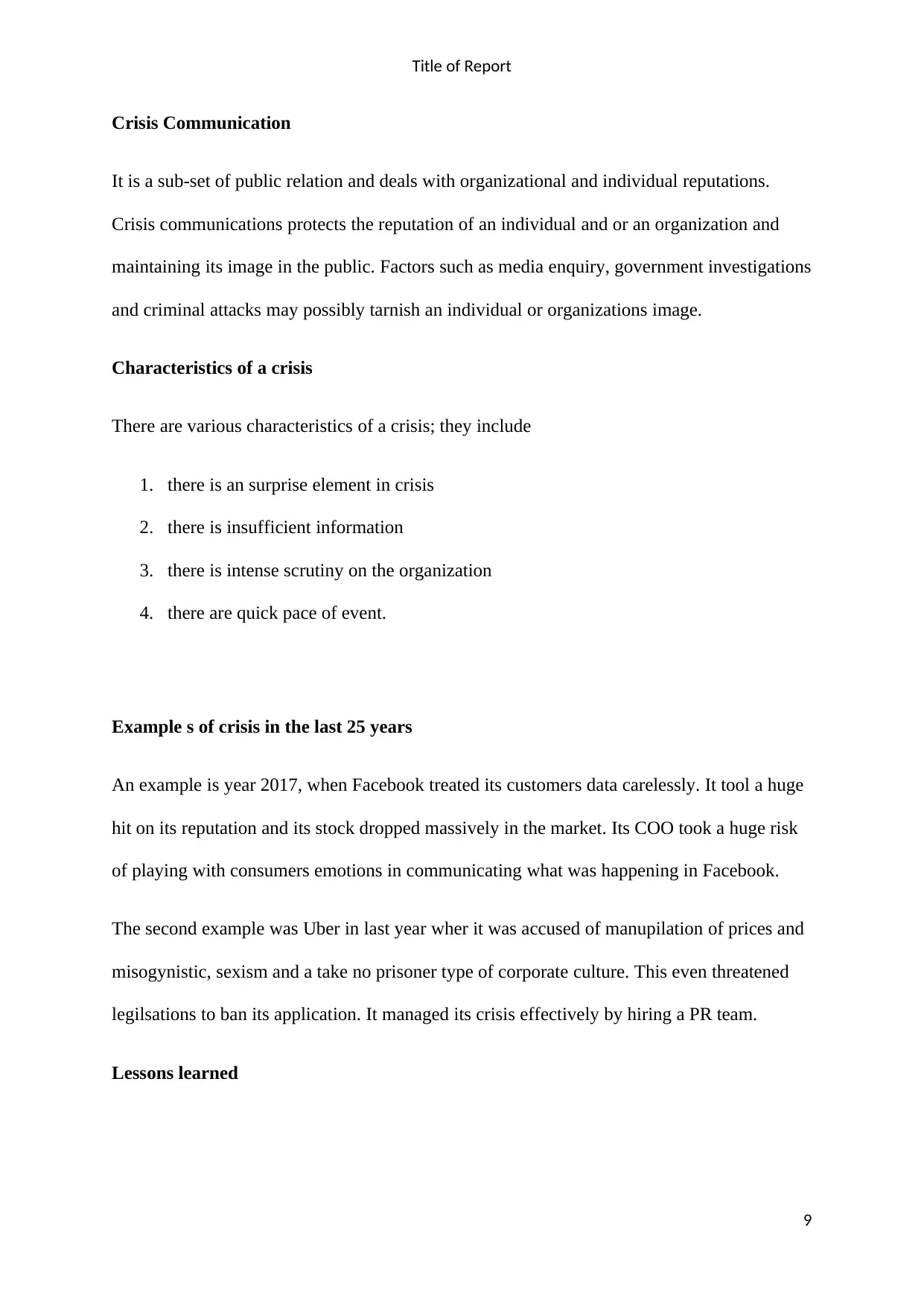
Title of Report
Crisis Communication
It is a sub-set of public relation and deals with organizational and individual reputations.
Crisis communications protects the reputation of an individual and or an organization and
maintaining its image in the public. Factors such as media enquiry, government investigations
and criminal attacks may possibly tarnish an individual or organizations image.
Characteristics of a crisis
There are various characteristics of a crisis; they include
1. there is an surprise element in crisis
2. there is insufficient information
3. there is intense scrutiny on the organization
4. there are quick pace of event.
Example s of crisis in the last 25 years
An example is year 2017, when Facebook treated its customers data carelessly. It tool a huge
hit on its reputation and its stock dropped massively in the market. Its COO took a huge risk
of playing with consumers emotions in communicating what was happening in Facebook.
The second example was Uber in last year wher it was accused of manupilation of prices and
misogynistic, sexism and a take no prisoner type of corporate culture. This even threatened
legilsations to ban its application. It managed its crisis effectively by hiring a PR team.
Lessons learned
9
Crisis Communication
It is a sub-set of public relation and deals with organizational and individual reputations.
Crisis communications protects the reputation of an individual and or an organization and
maintaining its image in the public. Factors such as media enquiry, government investigations
and criminal attacks may possibly tarnish an individual or organizations image.
Characteristics of a crisis
There are various characteristics of a crisis; they include
1. there is an surprise element in crisis
2. there is insufficient information
3. there is intense scrutiny on the organization
4. there are quick pace of event.
Example s of crisis in the last 25 years
An example is year 2017, when Facebook treated its customers data carelessly. It tool a huge
hit on its reputation and its stock dropped massively in the market. Its COO took a huge risk
of playing with consumers emotions in communicating what was happening in Facebook.
The second example was Uber in last year wher it was accused of manupilation of prices and
misogynistic, sexism and a take no prisoner type of corporate culture. This even threatened
legilsations to ban its application. It managed its crisis effectively by hiring a PR team.
Lessons learned
9
⊘ This is a preview!⊘
Do you want full access?
Subscribe today to unlock all pages.

Trusted by 1+ million students worldwide
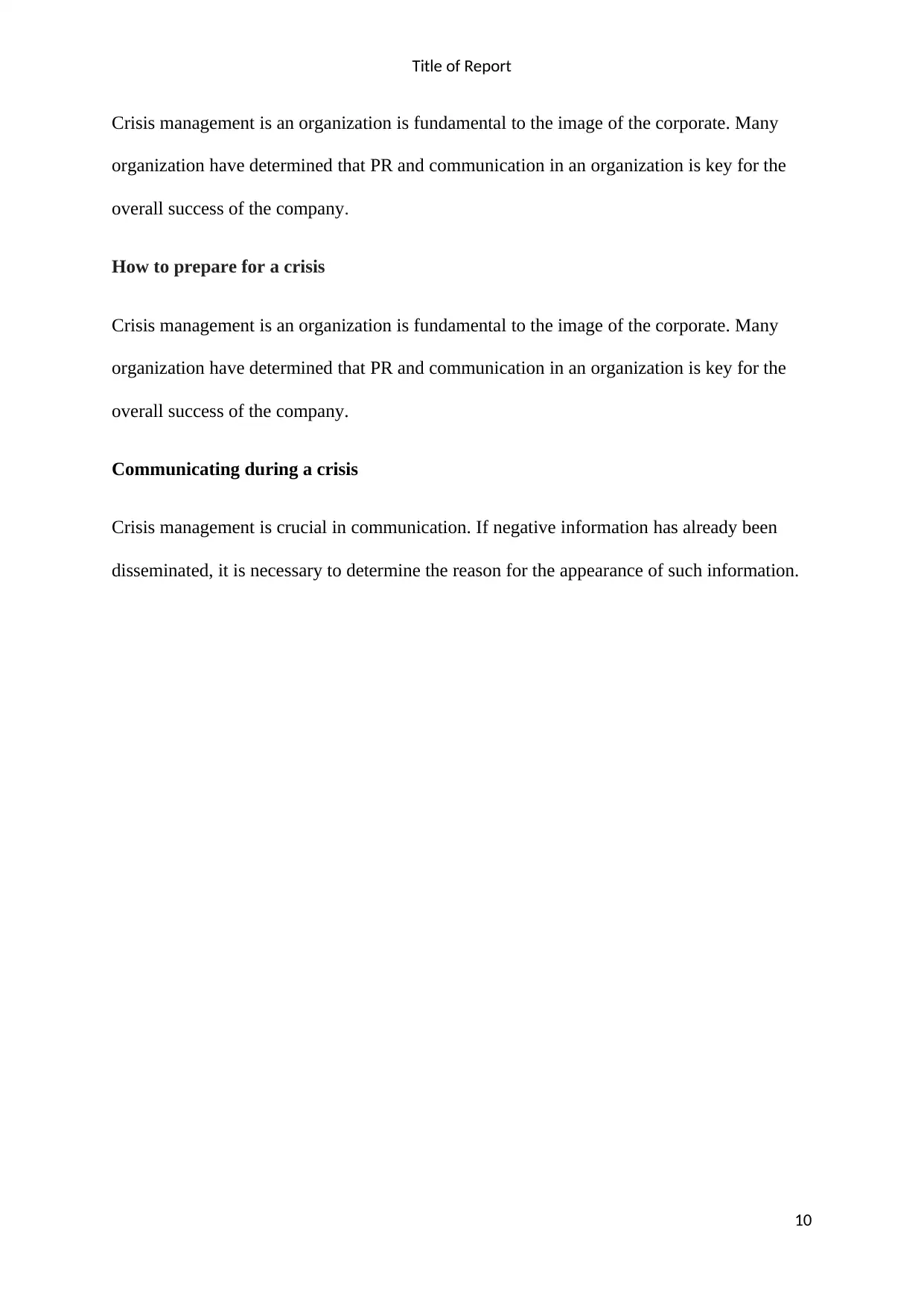
Title of Report
Crisis management is an organization is fundamental to the image of the corporate. Many
organization have determined that PR and communication in an organization is key for the
overall success of the company.
How to prepare for a crisis
Crisis management is an organization is fundamental to the image of the corporate. Many
organization have determined that PR and communication in an organization is key for the
overall success of the company.
Communicating during a crisis
Crisis management is crucial in communication. If negative information has already been
disseminated, it is necessary to determine the reason for the appearance of such information.
10
Crisis management is an organization is fundamental to the image of the corporate. Many
organization have determined that PR and communication in an organization is key for the
overall success of the company.
How to prepare for a crisis
Crisis management is an organization is fundamental to the image of the corporate. Many
organization have determined that PR and communication in an organization is key for the
overall success of the company.
Communicating during a crisis
Crisis management is crucial in communication. If negative information has already been
disseminated, it is necessary to determine the reason for the appearance of such information.
10
Paraphrase This Document
Need a fresh take? Get an instant paraphrase of this document with our AI Paraphraser
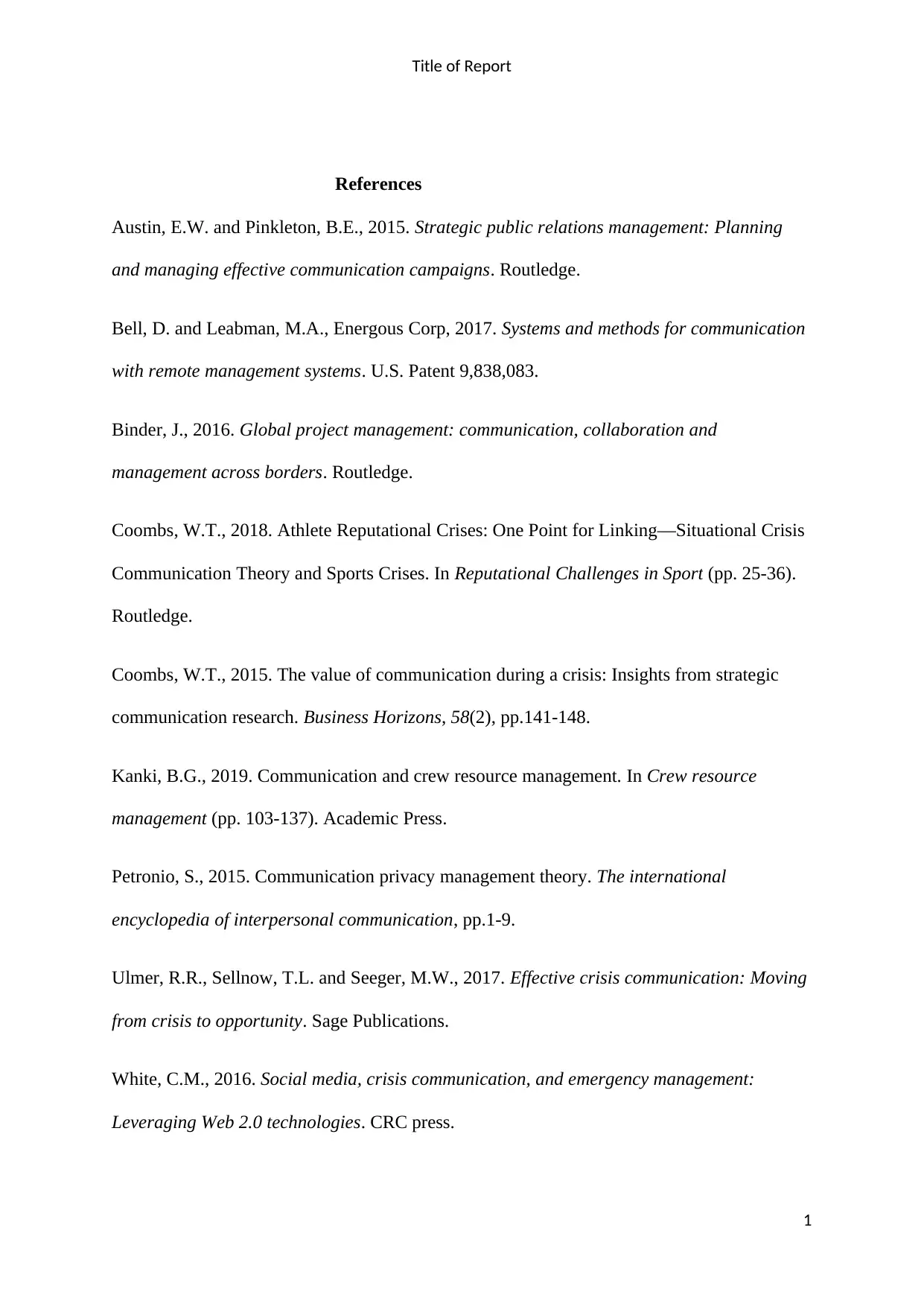
Title of Report
References
Austin, E.W. and Pinkleton, B.E., 2015. Strategic public relations management: Planning
and managing effective communication campaigns. Routledge.
Bell, D. and Leabman, M.A., Energous Corp, 2017. Systems and methods for communication
with remote management systems. U.S. Patent 9,838,083.
Binder, J., 2016. Global project management: communication, collaboration and
management across borders. Routledge.
Coombs, W.T., 2018. Athlete Reputational Crises: One Point for Linking—Situational Crisis
Communication Theory and Sports Crises. In Reputational Challenges in Sport (pp. 25-36).
Routledge.
Coombs, W.T., 2015. The value of communication during a crisis: Insights from strategic
communication research. Business Horizons, 58(2), pp.141-148.
Kanki, B.G., 2019. Communication and crew resource management. In Crew resource
management (pp. 103-137). Academic Press.
Petronio, S., 2015. Communication privacy management theory. The international
encyclopedia of interpersonal communication, pp.1-9.
Ulmer, R.R., Sellnow, T.L. and Seeger, M.W., 2017. Effective crisis communication: Moving
from crisis to opportunity. Sage Publications.
White, C.M., 2016. Social media, crisis communication, and emergency management:
Leveraging Web 2.0 technologies. CRC press.
1
References
Austin, E.W. and Pinkleton, B.E., 2015. Strategic public relations management: Planning
and managing effective communication campaigns. Routledge.
Bell, D. and Leabman, M.A., Energous Corp, 2017. Systems and methods for communication
with remote management systems. U.S. Patent 9,838,083.
Binder, J., 2016. Global project management: communication, collaboration and
management across borders. Routledge.
Coombs, W.T., 2018. Athlete Reputational Crises: One Point for Linking—Situational Crisis
Communication Theory and Sports Crises. In Reputational Challenges in Sport (pp. 25-36).
Routledge.
Coombs, W.T., 2015. The value of communication during a crisis: Insights from strategic
communication research. Business Horizons, 58(2), pp.141-148.
Kanki, B.G., 2019. Communication and crew resource management. In Crew resource
management (pp. 103-137). Academic Press.
Petronio, S., 2015. Communication privacy management theory. The international
encyclopedia of interpersonal communication, pp.1-9.
Ulmer, R.R., Sellnow, T.L. and Seeger, M.W., 2017. Effective crisis communication: Moving
from crisis to opportunity. Sage Publications.
White, C.M., 2016. Social media, crisis communication, and emergency management:
Leveraging Web 2.0 technologies. CRC press.
1

Title of Report
Ziek, P. and Anderson, J.D., 2015. Communication, dialogue and project
management. International Journal of Managing Projects in Business, 8(4), pp.788-803.
2
Ziek, P. and Anderson, J.D., 2015. Communication, dialogue and project
management. International Journal of Managing Projects in Business, 8(4), pp.788-803.
2
⊘ This is a preview!⊘
Do you want full access?
Subscribe today to unlock all pages.

Trusted by 1+ million students worldwide
1 out of 13
Related Documents
Your All-in-One AI-Powered Toolkit for Academic Success.
+13062052269
info@desklib.com
Available 24*7 on WhatsApp / Email
![[object Object]](/_next/static/media/star-bottom.7253800d.svg)
Unlock your academic potential
Copyright © 2020–2025 A2Z Services. All Rights Reserved. Developed and managed by ZUCOL.




